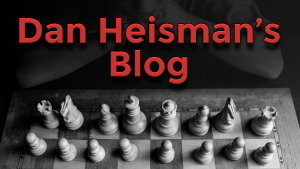Q&A with Coach Heisman Mar 15, 2013
Today's show coincided with the first round of the Candidates Tournament in London. Unfortunately, none of the games were exciting (all draws, most fairly short), so it was not a big topic of conversation.
However, I was asked who I thought would win. Whenever I have been asked that question I turn it around a little and say "Let's lump the Candidates and the World Championship as one event producing a World Chess Champion in 2013. If one person offers the bet that Magnus Carlsen will be World Champion and you can take the other 8 (including Anand) in a 50-50 bet, who would you take?" If Carlsen were only 15 rating points higher than everyone else, he would be a plurality favorite but not a majority and you should take "everyone else". But Carlsen is much higher than that - about 60 points above everyone - so a 50-50 bet with him against everyone else is worthy of consideration.
I got the usual set of "I am stuck at 2000 (or rating X); what should I do?" questions. I am not sure whether these are serious or not. If not, ignoring the question is reasonable. But I am sure some of these are serious, so what do they expect me to say without additional relevant information? (choose your favorite):
A: "Since you are 2000 and every 2000 gets stuck doing X, then here's how you should overcome X...",
B: "You are 2000 and did not mention any of your weaknesses, so let me use my clairvoyance. Ah, Yes! I am starting to see... You seem to think that the exchange is worth 2 pawns so you rarely give up the exchange without getting at least two additional pawns in return, when getting one pawn and other compensation is often more than enough. Your other problem is you often make quiescence errors when analyzing for less than 2 minutes on a move, so you need to take slightly longer when you see lines that are critical and not stop analyzing without checking to see if there are further checks, captures, or threats of relevance,
C) You are 2000 but I perceive you are in a club with primarily players lower than you and don't get to analyze with stronger players. So seek out tournaments with strong players and see if you can play them regularly, making sure to analyze the games with them afterwards, or
D) You have a rare mental condition which makes it very easy to play complex musical scores on various instruments, but which caps your chess play at about 2000. If you just eat carrots for about 100 straight days and get plenty of sun, your frontal cortex will start to change and your musical abilities will decline, but your chess barrier will be broken!" 
On the same question, I do have an column addressing "Breaking Slumps", which also deals with "ruts" when you get "stuck".
Someone asked me about the Icelandic Gambit (1.e4 d5 2.exd5 Nf6 3.c4 e6 4.dxe6). I have always felt that playing gambits was good for learning tactical play, and especially good for inexperienced players whose opponents don't defend well and probably couldn't easily win even if the attack fails and they were up a pawn. I then discussed beating soon-to-be-GM Rashid Ziatdinov at the 1998 World Open G/15 Championship with the Icelandic (click on the moves for occasional light notes):
- 1) Find a position worth analyzing. I suggest an unbalanced position such as one where a strong player has sacrificed material for some other consideration, such as activity or king safety. I have a couple of examples on my website, but they are easy to find in the games of dynamic players such as GM Shirov.
- 2) Get out a pencil and paper. Without a clock and without moving the pieces, spend as much time as you need writing down all the analysis (with evaluations of lines, using +=, +/-, +-, etc) necessary to prove what you think is the best move. If the position is sufficiently meaty, this will take 3-4 sides of a sheet of paper and possibly a couple of hours (less for less complex positions),
- 3) When finished, you should have an attempted proof on what is the best move.
- 4)To get the most of the exercise, show your work to a strong player and review the lines with him/her. Look for analysis errors, such as missed tactics, visualization errors, etc. Also pay attention to the evaluations at the end of each line to see if they were reasonable.
- 5)If you don't have a strong player available (or possibly even if you do), you can check the lines with a strong engine. It at least will be able to show you if your analysis was complete and correct, measure all your evaluations, and show whether you chose the right move.
 . But even if he gained 400 rating points in a year or two, that's quite a bit, let's say de la Maza-like.
. But even if he gained 400 rating points in a year or two, that's quite a bit, let's say de la Maza-like.Some of the books and articles mentioned on the show (with links for the non-books):
- Looking for Trouble (book) - Heisman
- Tune Your Chess Tactics Antenna (new book from NIC) - Neiman
- Revisiting the Seeds of Tactical Destruction - column
- Winning Chess Exercises for Kids (book) - Coakley
- Back to Basics: Tactics (book) - Heisman
- Winning Chess Strategy for Kids (book) - Coakley
- Chess Strategy for Club Players (book) - Grooten
- Whatever Happened to Everyone's Second Chess Book? (blog)
- Middlegame Book Suggestions (blog)
- My Top Tips for Chess Improvement (column)
- Not All Bads are Equal (column)
- More Pawns in the Center are Good (column)
- Elements of Positional Evaluation (book) - Heisman
- Evaluation Criteria (column)
- US Chess Federation (website)
- Reviewing Chess Games (column)
Next show Mar 29 open to Diamond and Platinum members. Cya then!

